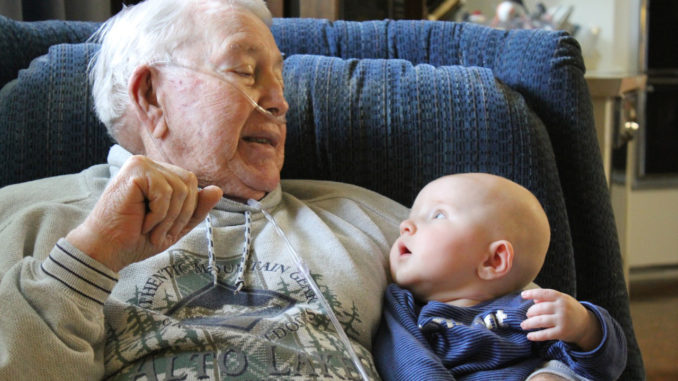
In January, Jack Spurlock was diagnosed with terminal lung cancer and was told he would live for only a few short months. His family felt helpless and he could only sit at home, waiting to die.
“He was on an oxygen machine and could barely walk across the room without stopping,” said his daughter, Stacey Harberson of Luling.
Harberson heard about a controversial treatment: hydrogen peroxide therapy. The therapy entails taking a few drops of diluted, food-grade hydrogen peroxide by mouth each day.
Within a month and a half of taking the peroxide, family members say that Spurlock’s condition improved drastically – he was no longer coughing up blood and only had to use an oxygen tank at night.
“After the peroxide therapy, it pretty much went from him waiting to die to him still being here and doing very well,” Harberson said.
Spurlock’s trouble began when he thought he had a toothache last November. He went to a dentist, who sent him to an ear, nose and throat doctor. A mass was found in his jaw which led to numerous tests. He was diagnosed with lung and thyroid cancer. This was not Spurlock’s first battle with cancer – he lost half of his nose to skin cancer two years ago.
By January, Spurlock, who also suffers from emphysema, was ailing. He could not walk or talk without oxygen and he was coughing up blood. Doctors said that the tumor in his lung was growing so rapidly that he likely had only two to four months left to live.
“Doctors pretty much told us it was growing so fast that they didn’t recommend any treatment…they felt that what little time he had left he should just enjoy with his family,” Harberson said.
Shortly after his diagnosis, Harberson heard about hydrogen peroxide therapy from a friend who was also battling cancer. The theory behind the therapy is that cancer thrives in oxygen-depleted areas, so diffusing oxygen into the body should keep the cancer cells from growing.
Spurlock got some of the food-grade hydrogen peroxide from her friend. Food-grade hydrogen peroxide comes in a 37 percent concentration and can be ordered through the internet, pharmacies or health-food stores.
Over-the-counter peroxide used to treat cuts is about 3 percent concentration and cannot be taken internally.
The cancer-stricken 76-year-old began by taking one drop of peroxide diluted in 8 ounces of water per day and worked his way up to 15 drops per day.
Cheryl Spurlock, Jack’s wife, said that the change was amazing.
“The first two months he really wasn’t moving too much, but after he started taking the drops it’s like he was doing better,” Mrs. Spurlock said.
The family took him back to the doctor and Harberson said scans showed that the mass in Spurlock’s lung had stopped growing. They said doctors also seemed more optimistic about Spurlock’s condition after he had been taking the hydrogen peroxide.
“The (doctors) said ‘Whatever you’re doing is apparently working, so you need to continue,’” Harberson said.
Supporters of peroxide therapy not only believe that adding oxygen to the body creates a condition where cancer cells cannot thrive, but also that the treatment increases the efficiency of all cells and increases energy, promotes the production of antioxidants and enhances the immune system.
In the 1930s, Nobel Prize Winner Dr. Otto Warburg discovered that cancer cells have a lower respiration rate than normal cells and reasoned that cancer thrives in a low-oxygen environment. Therefore, increased oxygen levels might harm and even kill the cancer cells. Studies since then have shown that some cancer patients benefit from the therapy while others do not, the American Cancer Society’s website says.
The society lists hydrogen peroxide therapy, also called oxygen therapy, as an alternative treatment to cancer that has not been scientifically proven.
The organization states that there have even been reports of patient deaths from this method when used inappropriately.
But Spurlock’s family said that after diluting the peroxide in water, he did not experience any negative side effects from using the peroxide.
Spurlock is continuing the therapy every night before bed and has lived to see many more months than doctors believed possible. He was able to attend his grandchild’s high school graduation in May and can walk and talk without being hooked up to an oxygen tank.
“He’s doing so much better – it was a lot of prayers and the peroxide,” Mrs. Spurlock said.




Be the first to comment